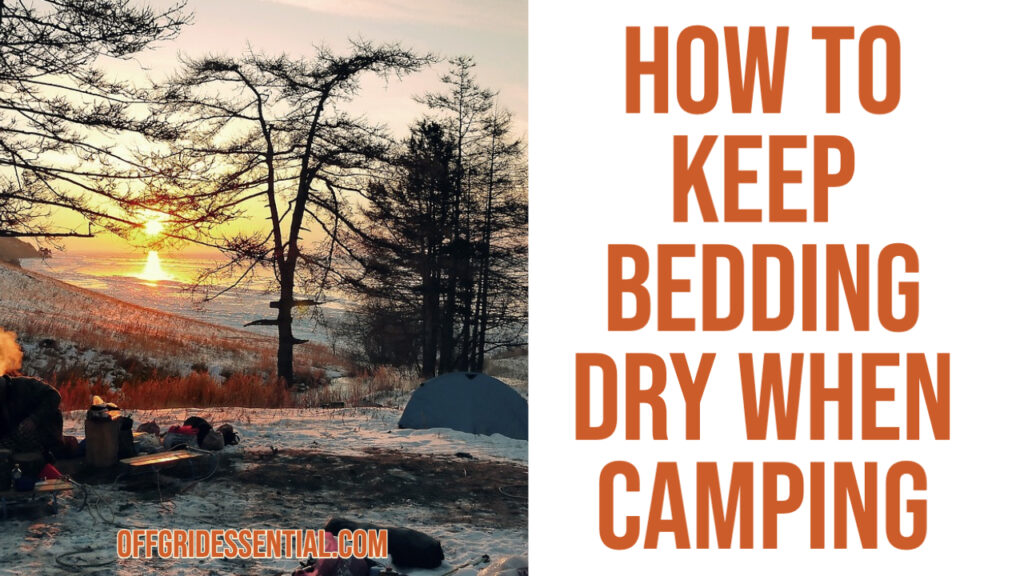Ever wake up in the morning when camping and all your bedding seems moist or flat out wet? Well, there is a way to fix that, let’s chat about it.

I love almost every aspect of camping, but if there was one area that I had to say makes the trip a little uncomfortable, it is damp or wet bedding.
It makes sleeping a pain, but it can also really make the whole tent feel nasty pretty quickly, especially if you’re sleeping in an uncomfortable environment for more than a few nights.
That’s why keeping your bedding dry is so important when camping because it can literally change the outcome of a trip.
Dry bedding means a more comfortable night’s sleep, and therefore a better time whilst away. So, here’s how to keep bedding dry when camping!
Think About Campsite Location
What I’ve noticed over the years is how easy it is to make a mistake whilst camping that will set you up for an uncomfortable trip right away, and this first point is definitely an example of this.
If you pick the wrong location for your camp, then you can kiss goodbye to dry bedding from the start. It really is that big of a decision to make.
You see, picking a location that is too hot can actually make moisture inside the tent a real problem.
This moisture then drips down from the walls and ceiling of the tent whilst you’re out enjoying your day, leaving your sleeping bag and bedding soaked through by the time you return in the evening.
By this point, of course, it’s already too late and you will need to be prepared for an uncomfortable night.
The best places I’ve found over the years are always places where I’ve been able to pitch my tent in the shade of some trees, to keep it cooler throughout the day when the temperature really spikes.
I’ve also found that directing my tent in the direction that the wind most often blows from also helps.
I’ll make a special point out of airflow later, but suffice to say that making sure there is a continuous supply of fresh, cool air is one of the best ways to prevent moisture from ruining your bedding.
Check out our guide to finding BLM free camping areas here.
Don’t Unpack Too Soon
I see this so often and it makes me cringe for new campers, because I know how disappointed they’re going to be when they get back from their day enjoying the outdoors.
There’s a reason sleeping bag manufacturers provide a bag to carry it in, and it’s to help prevent moisture from building up. This bag is waterproof, and it protects your sleeping bag from the elements.
So, don’t just unpack the moment you arrive at your campsite, wait until the sun has gone down and it’s cooler before you lay out your sleeping bag and bedding.
Another note on this that I know already is going to annoy some of you is that you really should pack up your bedding every morning too to help keep it fresh and away from anything that can make it wet.
I know, you don’t want to stuff a sleeping bag into its carry bag every morning – I’m guilty of not doing it too – but I can assure you that if you do, you’ll have a more comfortable night’s sleep when you unpack it again in the evening.
Waterproof Groundsheet
Before you even think about unpacking anything, do me a favor and throw down a waterproof groundsheet if your tent doesn’t have one already. Even if it does, an extra one can make a difference.
Without it though, the moisture that builds up on the grass outside naturally overnight will penetrate your tent’s material and soak your sleeping bag and bedding.
Morning dew is a wonderful thing to look at with a cup of coffee outside your tent in the morning, but it isn’t so wonderful if your sleeping bag is soaked with the stuff when you first wake up.
It’s just a precaution, but something that will certainly help. Check to see if your tent has one built in, and then look at the reviews online to see if people think it actually helps.
It might be that picking up a more durable one is better for you, but that depends on the manufacturers and what their customers think of the groundsheet. Either way, a waterproof groundsheet will keep your bedding dry!
Think About Airflow
Airflow is one of the most important things to consider when keeping your bedding dry when camping.
Moisture builds in the air naturally, and without somewhere to escape, it will form droplets inside your tent and soak everything through, creating a humid, uncomfortable environment for you at night time.
Even when you’re inside your tent, make sure you open all the air inlets to keep airflow good, and think about opening your tent door every morning to let some air in and take away some of the moisture that will have built up overnight. This is something I make sure I do, even on chilly nights.
Having good airflow will help keep your bedding dry, and besides, it’s always hot inside tents anyway, so a little cool air won’t do you any harm.
Sleeping Bag Liner
Speaking of it being hot inside tents, this last point is also essential to keeping your bedding dry. Even if you’re sleeping on a mattress without a sleeping bag, a liner will still help keep things dry.
This time we’re not trying to keep your bedding dry from moisture in the air, but moisture from… you.
Gross, right? But everybody sweats, and everybody sweats more inside tents, so a sleeping bag liner is the best way to make sure all your sweat doesn’t get soaked up by your sleeping bag.
If you don’t use a liner and you’re away for more than a night or two, your bedding can become pretty grubby pretty fast, so using a liner doesn’t just help keep your bedding dry, but it’s more hygienic too!
Things To Remember
Just to finish, I wanted to give a quick summary of the major points of this post, so you can try to remember the key bits next time you’re camping.
The number one thing you need to do is keep good airflow, because if it’s too warm inside your tent, then you’re guaranteed to have wet bedding.
Keep everything cool, airflow good, and be mindful of leaving your bedding in places where it can get wet easily, and you should have a comfortable camping trip! Check out a few more tips about sleeping bag condensation here from the fokls at Pure Hiker.
